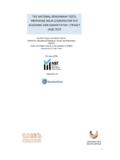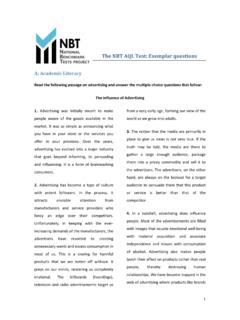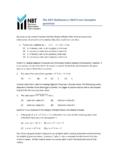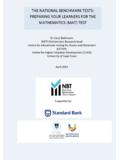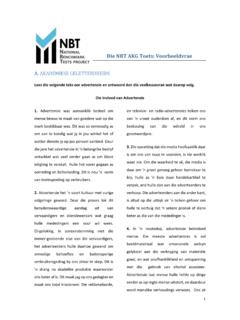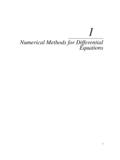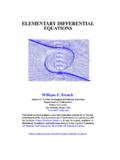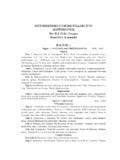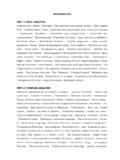Transcription of THE NATIONAL BENCHMARK TESTS: PREPARING …
1 Dr Carol Bohlmann THE NATIONAL BENCHMARK tests : PREPARING your learners FOR THE MATHEMATICS (MAT) TEST Dr Carol Bohlmann NBTP Mathematics Research Lead Centre for Educational Testing for Access and Placement (CETAP): Centre for Higher Education Development (CHED) University of Cape Town April 2015 Supported by: Contents INTRODUCTION 3 1. BACKGROUND AND PURPOSE OF THE MAT tests 4 1a. MATHEMATICS TEST ACHIEVEMENT LEVELS 4 2. NSC and NBT 8 2a. NBT TOPICS IN THE NSC CONTEXT 8 2b. COMPLEMENTARITY OF NSC MATHEMATICS AND NBT MAT tests 9 2c. DIFFERENCES BETWEEN THE NSC MATHEMATICS EXAM AND THE MAT tests 10 3. WHAT CAN WE EXPECT FROM THE MAT tests ? 13 3a.
2 MAT TEST TOPICS 13 4. WHAT SHOULD TEACHERS DO? 16 4a. PRINCIPLES FOR PROACTIVE TEACHING 16 5. PREPARING FOR THE NBTs 19 5a. Internet assistance 19 5b. Extra lessons 19 6. FREQUENTLY ASKED QUESTIONS ABOUT THE MAT tests : TWO QUESTIONS THAT BOTHER PARENTS AND TEACHERS 20 7. EXEMPLAR QUESTIONS 22 7a. A FEW SAMPLE QUESTIONS 22 2 INTRODUCTION This booklet will assist you in understanding what the NBT MAT test is about and tell you how to prepare your learners for it. The NATIONAL BENCHMARK tests (NBT) are a set of tests that measure an applicant s academic readiness for university. They complement and support, rather than replace or duplicate the NATIONAL Senior Certificate results.
3 A number of universities in South Africa use the NBTs to help interpret the NATIONAL Senior Certificate (NSC) results. Universities use the NBT results in different ways: - Some use them to help make decisions about an applicant s access to university. This means that the NBT results, in combination with the NSC results, are used to determine whether an applicant is ready for academic study. - Some use them for placement within university. This means that the results are used to decide whether an applicant will need extra academic support after he/she has been admitted to university. - Some use them to help develop curricula within their university. There are two tests : AQL, which is the Academic Literacy and Quantitative Literacy test, and MAT, which is the Mathematics test.
4 3 1. BACKGROUND AND PURPOSE OF THE MAT tests 1a. MATHEMATICS TEST ACHIEVEMENT LEVELS To determine whether learners are able to make the transition between mathematics at secondary and tertiary level, the competencies that are required, but not necessarily made explicit, by Higher Education, need to be assessed. NBT test writers are placed in one of three categories: Basic, Intermediate, and Proficient. For the Mathematics (MAT) tests , what does this mean? Have a look at the Achievement Levels below. You will see how much more is required for writers to move from the Basic category into the Intermediate category; similarly from Intermediate to Proficient.
5 The table is based on the topics outlined under the heading MAT TEST TOPICS . BASIC INTERMEDIATE PROFICIENT Test writers performing at the Basic level will be able to apply simple concepts and use known procedures in familiar situations. In general they will cope with tasks that involve recall and reproduction of basic mathematical facts or performance of simple computations. Basic writers will typically be able to apply a single representation or technique to a single piece of information. Test writers performing at the Intermediate level should be able to perform at the Basic level, and in addition be able to select strategies to solve problems and integrate skills, concepts and procedures.
6 In general writers at this level will be able to manage mathematical tasks involving multiple steps requiring information processing and decision-making skills. Writers will typically be able to make connections between, and integrate, more than one piece of information, use various mathematical procedures and multiple representations in a sequence of steps. Test writers performing at the Intermediate level should be able to interpret an argument NBT writers performing at the Proficient level should be able to perform at the Intermediate level, and in addition demonstrate in-depth knowledge of the relevant mathematical concepts and competence in multi-step procedures represented in the framework.
7 Proficient level test writers should be able to demonstrate insight and integrate knowledge to solve complex problems. They should be able to make competent use of logical skills such as making conjectures and proving the validity of deductions. 4 and make logical deductions in the context of a wide variety of mathematical tasks. Algebraic Processes: Test writers should be able to perform routine computations with real numbers perform simple algebraic manipulations identify simple number patterns (sequences) use variables that represent unknown quantities use expressions and equations that express simple relationships among unknown quantities recognise and use familiar formulae solve routine equations in one variable perform routine financial calculations Algebraic Processes.
8 Test writers should be able to estimate and calculate recognise and work with patterns (including geometric and arithmetic sequences) compare measures demonstrate understanding of the properties of inequality perform multi-step algebraic manipulations manipulate a variety of algebraic expressions, including those that involve surds, exponents and logarithms solve non-routine equations in one variable, solve systems of linear equations model situations ( analyse given information, make an appropriate representation of the information) and solve problems using a variety of mathematical processes Algebraic Processes: Test writers should be able to select and adapt appropriate formulae to solve non-routine problems solve and interpret systems of equations and inequalities Functions and graphs: Test writers should be able to identify graphs of functions noted above solve routine problems involving functions expressed in a single form, whether verbally, algebraically or graphically Functions and graphs.
9 Test writers should be able to use and interpret the graphs noted above solve non-routine problems involving functions expressed in multiple forms manage multiple representations of functions, and interpret the information demonstrate understanding of various characteristics of Functions and graphs: Test writers should be able to interpret the relationship between functions and their inverses demonstrate understanding of the domain and range of a variety of composite functions, including trigonometric functions determine and interpret the meaning of gradients of certain functions and use the relationship between slope and tangent 5 individual functions (including trigonometric functions) such as domain and range, interpret transformations and reflections of functions apply the principles of differential calculus to functions, represented graphically or algebraically Trigonometry.
10 Test writers should be able to define specified trigonometric ratios in right triangle trigonometry recognise trigonometric graphs perform basic calculations with trigonometric ratios solve simple trigonometric equations recognise and use identities, compound angle formulae and reduction formulae Trigonometry: Test writers should be able to apply trigonometric ratios to solve two-dimensional problems understand the properties of trigonometric graphs, including translations of these graphs apply the sine, cosine and area rules in simple contexts solve non-routine trigonometric equations apply trigonometric identities, reduction formulae and knowledge of special angles to solve problems Trigonometry: Test writers should be able to interpret graphs of trigonometric functions, individually and in relation to one another apply trigonometric concepts to solve non-routine problems in two- and three-dimensional contexts Spatial perception.
